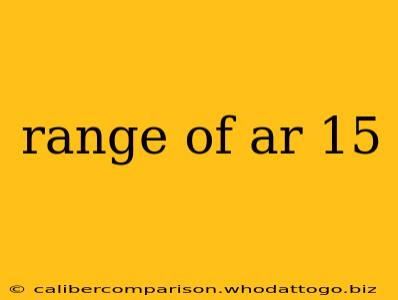The effective range of an AR-15 is a frequently debated topic, often misunderstood and influenced by various factors. It's not a simple answer like "X yards," but rather a nuanced discussion encompassing accuracy, projectile limitations, and the shooter's skill. This comprehensive guide will break down the different ranges and clarify what they mean for both recreational and tactical use.
What is "Effective Range"?
Before diving into specifics, let's define "effective range." This term refers to the maximum distance at which a firearm can consistently deliver accurate and lethal shots given the projectile's characteristics and the shooter's proficiency. It's not about simply hitting a target; it's about achieving a desired level of accuracy needed for the intended purpose. For self-defense, a smaller target area (like the torso) may influence the effective range more than when shooting at a larger, inanimate target at a long-range competition.
AR-15 Effective Range: A Breakdown
The general consensus among firearms experts places the maximum effective range of an AR-15 with standard ammunition around 300-500 yards. However, this range is heavily dependent on several critical variables:
1. Ammunition:
- .223 Remington/5.56 NATO: The most common ammunition for AR-15s. While it can reach 500 yards, accuracy diminishes significantly beyond 300 yards. Beyond this point, bullet drop, wind drift, and environmental factors become increasingly difficult to compensate for, even for experienced shooters.
- Heavier Grain Ammunition: Using heavier-grain bullets can extend the effective range slightly by improving ballistic performance. These bullets have less bullet drop and maintain velocity better at longer distances.
2. Barrel Length:
- Barrel length significantly influences velocity. Longer barrels generally impart higher muzzle velocities, leading to a flatter trajectory and potentially increasing effective range. However, the increase in range is less significant than you might expect, and other factors like weight and maneuverability need to be considered.
3. Optics:
- Proper sighting equipment is crucial. Using a quality optic with adequate magnification (e.g., a 4x or higher magnification scope) is essential for accurately engaging targets at longer ranges. Iron sights are generally adequate for shorter ranges but become less practical beyond 200 yards.
4. Shooter Skill:
- Marksmanship is paramount. Even with ideal ammunition and equipment, an unskilled shooter will not achieve the maximum effective range. Consistent practice and training are crucial for achieving accuracy at any distance.
5. Environmental Factors:
- Wind, temperature, and humidity all impact trajectory. These factors must be considered and accounted for, especially at longer ranges.
Beyond Effective Range: Maximum Range vs. Practical Range
It's important to distinguish between "effective range," "maximum range," and "practical range."
- Maximum Range: This refers to the furthest distance a bullet can travel before hitting the ground. For an AR-15, the maximum range can be significantly further than the effective range, possibly exceeding 1 mile, but accuracy is almost non-existent at this distance.
- Practical Range: This considers the shooter's ability, environmental conditions, and the realistic scenario. For most recreational or defensive purposes, the practical range may be considerably less than the effective range.
Conclusion:
The effective range of an AR-15 isn't a fixed number. It's a dynamic range dependent on numerous interacting factors. While an AR-15 can reach out to 500 yards, achieving consistent accuracy and lethality beyond 300 yards requires significant skill, optimal ammunition selection, appropriate optics, and understanding of environmental influences. Always prioritize responsible gun handling, safe practices, and appropriate training. This information is for educational purposes only and does not constitute professional firearms advice. Consult with experienced firearms instructors and adhere to all local and national regulations.

